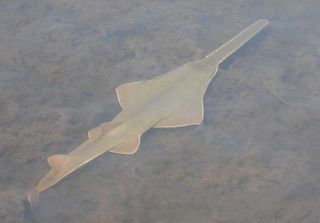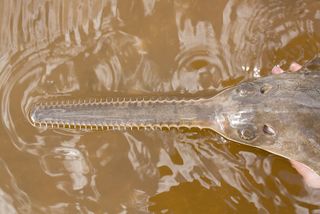Smalltooth sawfish
The smalltooth sawfish (Pristis pectinata) is a cartilaginous fish that belongs to the Subclass Elasmobranchii, which also includes all sharks and rays.[1] This dorsally tannish-brown fish can reach a total length of up to 18 feet (5.5 meters) including the saw (Bigelow and Schroeder 1953). The species’ common and scientific names are derived from its long, flattened, toothed rostrum (nose or beak structure) that extends outward from its flattened head. The rostrum resembles a saw because it has 24–32 unpaired saw teeth on each side. Rostral teeth that are lost will not grow back; however, chipped teeth will continue to grow as long as the base is intact (Slaughter and Springer 1968). The mouth teeth are small and flat like other rays. The smalltooth sawfish is considered a type of ray, in part because the gill slits are located on the bottom of the body and the pectoral fins are attached to the head.
Behavior
Little is known about what the smalltooth sawfish feeds on. Their diet is thought to consist of crabs, shrimp, small fish, and other bottom-dwelling organisms (Bigelow and Schroeder 1953). The saw is used to slash at prey in the water column and to dislodge prey from bottom-dwelling habitats.Pregnant females give birth in estuarine nursery areas primarily during April and May (Poulakis et al. 2011). Fertilization is internal and up to 20 embryos mature inside the mother with no placental connection. The reproductive cycle length of the smalltooth sawfish is not known. Smalltooth sawfish are born with fully-calcified rostral teeth that are covered by a protective sheath, which prevents the mother from being injured during birth. The sheath disappears and exposes the rostral teeth after about two weeks (Poulakis et al. 2011). Sexual maturity is reached at about four to five years of age for males; it takes longer for females but the rate is not exactly known (Simpfendorfer et al. 2008).
Habitat
Juvenile smalltooth sawfish habitats differ from adult habitats. Juveniles inhabit coastal areas such as estuaries, river mouths, and bays year-round. They have been recorded from a variety of habitat types including un-vegetated mud and sand bottoms, especially along red mangrove shorelines. Also, juveniles use creeks and canals that connect to the main stem of rivers as habitat. (Poulakis et al. 2010, 2011). Potential habitat includes waters under docks, bridges, and piers. Juveniles typically inhabit salinities between 18 and 30 parts per thousand (PPT) (the ocean is 35), sometimes miles up rivers (Poulakis et al. 2010, 2011; Simpfendorfer et al. 2011). Adult smalltooth sawfish are typically found in open water habitats, but have been encountered near coral reefs and occur inshore during the spring when females give birth and mating is thought to occur. Of seven species of sawfish found worldwide, the only species found in Florida waters is the smalltooth sawfish. Although the historical range of this species extended from the U.S. down to Brazil, all life stages of smalltooth sawfish are found primarily from Charlotte Harbor, Florida to the Florida Keys (Seitz and Poulakis 2002; Poulakis and Seitz 2004, Mote Marine Laboratory Database).
Threats
Historical threats have included unintentional overfishing associated with commercial fisheries, trophy fishing associated with recreational fisheries, and habitat destruction. The smalltooth sawfish population has been reduced to a small section of Florida’s southern coast; their core range used to reach in the U.S. from North Carolina to Texas (NMFS 2009a). Presently, fishing gear entanglements and habitat destruction are the main threats as the amount of recreational and commercial fishing has increased, and the development along Florida’s coast has caused damage to mangrove forests that serve as nursery areas for juvenile smalltooth sawfish (Seitz and Poulakis 2006; NMFS 2009a). Recent research has shown that water temperatures below ~53°F (12°C) cause smalltooth sawfish mortalities and this observation suggests that the northern limits of its year-round range may not have extended much further north of Florida (Poulakis et al. 2011). Seasonal movements of adult smalltooth sawfish that historically carried the species north of Florida during the summer may have been influenced by decreasing water temperatures. Despite the collapse of the smalltooth sawfish population during the last century, the remaining population appears to be genetically healthy (Chapman et al. 2011).
Conservation and Management
The smalltooth sawfish is protected as an Endangered species by the Federal Endangered Species Act and as a Federally-designated Endangered species by Florida’s Endangered and Threatened Species Rule. In the U.S., two broad areas of juvenile Critical Habitat were designated in 2009 to help protect the remaining population (NMFS 2009b).
Threatened Species List
The Smalltooth sawfish is listed as Critically Endangered (A2cd) on the International Union for Conservation of Nature and Natural Resources (IUCN) List of Threatened Species.[2]
The Smalltooth Sawfish (Pristis pectinata) has been wholly or nearly extirpated from large areas of its former range in the Atlantic Ocean by fishing (trawl and inshore netting) and habitat modification. Negative records from scientific surveys, anecdotal fisher observations, and fish landings data over its historic range infer a population reduction of ≥95% over a period of three generations (i.e., 1962 to present). The remaining populations are now small, and fragmented. The species can only be reliably encountered in the Bahamas (where suitable habitat is available) and the United States (Georgia south to Louisiana). It is rare but present in Honduras, Belize, Cuba, Sierra Leone, and possibly Guinea-Bissau and Mauritania. Threats to Smalltooth Sawfish still exist today in areas where sawfish are unprotected and habitat modification (mangrove removal) and inshore netting still occurs.[2]



